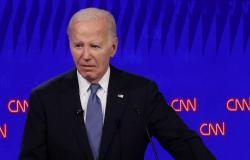
* High storage levels serve to calm market concerns
* The general director of THE: would not take action if the filling objectives were reached
THE CEO: Would not take action if filling targets are met * Thinks other origins could compensate for end of Russian gas transit
* LNG reception capacity is abundant around European coasts.
(Added context, winter preview, comment on possible end of Russian gas transit via Ukraine in paragraphs 4-11)
FRANKFURT, June 26 (Reuters) – Germany’s natural gas caverns, at just over 79% of capacity, are not far from the filling levels required by law for the coming winter of 2024/25 , said an industry executive.
“Underground stocks are currently well stocked,” said Torsten Frank, the director of Trading Hub Europe (THE), which coordinates a quarter of the storage capacity under a government mission, sending calming price signals to wholesale markets.
Germany’s storage facilities, with a capacity of 23 billion cubic meters, were 79.04% full on Monday, industry data showed.
THE, which is owned by gas pipeline companies, was tasked by the Berlin government in 2022, when Germany and much of Europe were virtually cut off from Russian gas, to create a public reserve of gas volumes. emergency of up to 50 terawatt hours (TWh), in order to complement the activities of private companies.
The company has successively sold all volumes by mid-May 2024, but will continue to purchase and place gas on the market until 2027, if necessary, to ensure compliance with the minimum storage levels required by law, it said.
The levels are not far from compliance, with 85% and 95% required for October 1 and November 1, respectively.
“If these goals are achieved, THE does not need to take any action,” Mr. Frank, one of four managing directors of the Ratingen-based company, said in an interview with Reuters on Tuesday and published on Wednesday.
If the transit of Russian gas via Ukraine to Austria stops from next January, Frank said he believes the European market could make up for volume losses with pipeline gas or natural gas. liquefied natural gas (LNG) from other regions to Northern Europe or the Mediterranean.
“The capacity of LNG terminals is sufficient and the corresponding transport capacities southwards from north-west Europe have been improved,” he said.
Ukraine has said it will not extend a five-year deal with Russia’s Gazprom on the transit of Russian gas to Europe when it expires at the end of the year.
The European Union also adopted a set of sanctions against Moscow aimed at reducing Russia’s revenue from LNG exports by banning transshipments from EU ports, which continued as the he gas supply via pipeline has largely dried up.
“There are many LNG suppliers, so sufficient volumes could be transported to Europe, even in the event of a potential ban on Russian LNG imports,” he said. (Reporting by Vera Eckert, Editing by Madeline Chambers, Miranda Murray and Emelia Sithole-Matarise)




